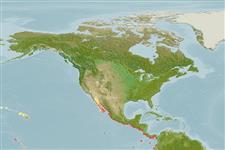Common names from other countries
>
Carangaria/misc (Various families in series Carangaria) >
Centropomidae (Snooks)
Etymology: Centropomus: Greek, kentron = sting + Greek, poma, -atos = cover, operculum (Ref. 45335).
More on author: Günther.
Environment: milieu / climate zone / depth range / distribution range
экология
морской; пресноводный; солоноватоводный демерсальный. Tropical; 29°N - 0°N, 113°W - 77°W
Eastern Pacific: southwestern coast of Baja California Sur, Mexico and the central Gulf of California to Ecuador.
Size / Вес / Возраст
Maturity: Lm ? range ? - ? cm
Max length : 65.0 cm TL самец/пол неопределен; (Ref. 55763); common length : 30.0 cm TL самец/пол неопределен; (Ref. 55763); наибольший вес (опубликованные данные): 3.2 kg (Ref. 40637)
Краткое описание
определительные ключи | морфология | морфометрия
Body slender and not very deep; dorsal profile slightly concave behind the eyes; lateral line extending to posterior edge of caudal fin; second anal spine, when folded down, not reaching origin of caudal fin; pectoral fins shorter than pelvic fins; anal fin with 7 rays; back blue or gray; belly silvery; lateral line dark. Membranes between second and third anal spines black; distal quarter of pelvic fins generally dark (Ref. 55763).
Adults inhabit bays and estuaries (Ref. 37955). Also found in high altitudes of at least 250 m elevation and a distance of some 20 km from the coast. They also occur in coastal waters, but is more abundant in estuaries of any size. Enter freshwaters mostly in large rivers and feeds on fish and crustaceans (Ref. 36880).
Life cycle and mating behavior
Maturities | размножение | Spawnings | Egg(s) | Fecundities | личинки
Bussing, W.A., 1995. Centropomidae. Róbalos. p. 987-995. In W. Fischer, F. Krupp, W. Schneider, C. Sommer, K.E. Carpenter and V. Niem (eds.) Guia FAO para Identification de Especies para lo Fines de la Pesca. Pacifico Centro-Oriental. 3 Vols. FAO, Rome. (Ref. 9284)
Статус Красного Списка МСОП (Ref. 130435)
CITES (Ref. 128078)
Not Evaluated
Угроза для людей
Harmless
Использование человеком
рыболовство: коммерческий; объект спортивного рыболовства: да
дополнительная информация
инструменты
Специальные отчеты
Скачать в формате XML
ресурсы в Интернет
Estimates based on models
Preferred temperature (Ref.
115969): 23.3 - 28.6, mean 27.5 (based on 36 cells).
Phylogenetic diversity index (Ref.
82804): PD
50 = 0.5005 [Uniqueness, from 0.5 = low to 2.0 = high].
Bayesian length-weight: a=0.00741 (0.00464 - 0.01185), b=3.04 (2.90 - 3.18), in cm Total Length, based on LWR estimates for this species & Genus-body shape (Ref.
93245).
Trophic level (Ref.
69278): 4.0 ±0.65 se; based on food items.
устойчивость к внешним воздействиям (Ref.
120179): средний (среднего размера), минимальное время удвоения популяции 1.4-4.4 года (Preliminary K or Fecundity.).
Fishing Vulnerability (Ref.
59153): Moderate to high vulnerability (46 of 100).
